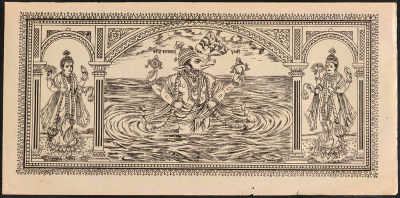
Varaha Purana
Encyclopedia

The Varaha Purana is one of the major eighteen Mahapurana
Mahapurana
Mahapurana may refer to:* one of the 18 major Hindu Puranas*Mahapurana , a well-known 9th century Jain text by Jinasena...
s, a genre of Hindu
Hindu
Hindu refers to an identity associated with the philosophical, religious and cultural systems that are indigenous to the Indian subcontinent. As used in the Constitution of India, the word "Hindu" is also attributed to all persons professing any Indian religion...
religious texts. It describes in detail about the Varaha
Varaha
Varaha is the third Avatar of the Hindu Godhead Vishnu, in the form of a Boar. He appeared in order to defeat Hiranyaksha, a demon who had taken the Earth and carried it to the bottom of what is described as the cosmic ocean in the story. The battle between Varaha and Hiranyaksha is believed to...
incarnation (Avatar
Avatar
In Hinduism, an avatar is a deliberate descent of a deity to earth, or a descent of the Supreme Being and is mostly translated into English as "incarnation," but more accurately as "appearance" or "manifestation"....
) of Vishnu
Vishnu
Vishnu is the Supreme god in the Vaishnavite tradition of Hinduism. Smarta followers of Adi Shankara, among others, venerate Vishnu as one of the five primary forms of God....
, and narrates about the rescue of the Prithvi
Prithvi
Prithvi is the sanskrit name for earth and its essence Prithivi Tattwa, in the form of a mother goddess or godmother. Prithvi is also called Dhra, Dharti, Dhrithri, meaning that which holds everything. As Prithvi Devi, she is one of two wives of Lord Vishnu. His other wife is Lakshmi. Prithvi is...
.
Contents
The printed editions of this work has 217 or 218 adhyāyas (chapters). According to the Narada Purana, this text is divided into two parts: purvabhaga and uttarabhaga. While the contents of the purvabhaga almost correspond to the extant text, the uttarabhaga, as described in the Narada Purana, where the main interlocutor is sage PulastyaPulastya
Pulatsya was one of the ten Prajapati or mind-born sons of Brahma, and one of the Saptarishis in the first Manvantara....
is not found in the text. According to R. C. Hazra, a modern scholar, the extant text has four distinct sections, differing in interlocutors and general characteristics. In the first section (chapters 1 to 112), Suta
Ugrasrava Sauti
Ugrashravas was the narrator of several Puranas, including Mahābhārata, Bhagavata Purana, Harivamsa, and Padma Purana, with the narrations typically taking place before the sages gathered in Naimisha Forest...
is the narrator and Varaha
Varaha
Varaha is the third Avatar of the Hindu Godhead Vishnu, in the form of a Boar. He appeared in order to defeat Hiranyaksha, a demon who had taken the Earth and carried it to the bottom of what is described as the cosmic ocean in the story. The battle between Varaha and Hiranyaksha is believed to...
and Prithvi
Prithvi
Prithvi is the sanskrit name for earth and its essence Prithivi Tattwa, in the form of a mother goddess or godmother. Prithvi is also called Dhra, Dharti, Dhrithri, meaning that which holds everything. As Prithvi Devi, she is one of two wives of Lord Vishnu. His other wife is Lakshmi. Prithvi is...
are the interlocutors. In the second section (chapters 113 to 192), Suta narrates what was told by Prithvi to Sanatkumara
Sanatkumara
Sage Sanatkumara was one of the Four Kumaras, the four Manasputras or spiritual sons of Brahma according to Puranic texts of Hinduism, including the Bhagavata Purana, whose other sons were Sanaka, Sanatana, and Sanandana . Sanatkumara in Sanskrit means "eternal youth"....
about the dialogue between Varaha and herself. In the third section (chapters 193 to 212), Suta describes the conversation between the king Janamejaya
Janamejaya
Janamejaya was a Kuru king. He was the son of Parikshit and Madravati. He was the grandson of Abhimanyu and the great-grandson of Arjuna, the valiant warrior hero of the Mahābhārata. He was ascended to the Kuru throne following the death of his father. His significance comes as the listener of the...
and the sage Vaishampayana. This section is also known as the Dharma Samhita. In the final section (chapters 213 to end), Suta narrates the conversation between Brahma
Brahma
Brahma is the Hindu god of creation and one of the Trimurti, the others being Vishnu and Shiva. According to the Brahma Purana, he is the father of Mānu, and from Mānu all human beings are descended. In the Ramayana and the...
and Sanatkumara.
Further reading
- Mani, Vettam. Puranic Encyclopedia. 1st English ed. New Delhi: Motilal Banarsidass, 1975.

